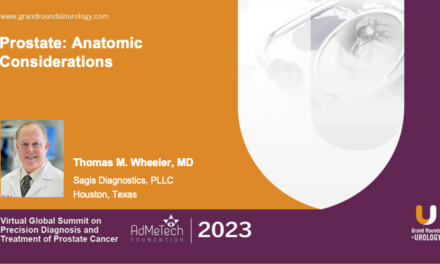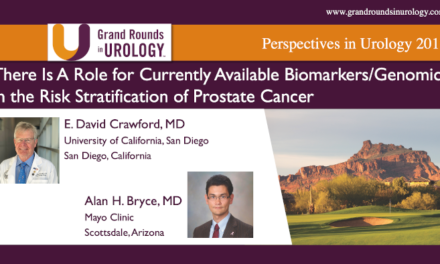Laurence Klotz, MD, FRCSC, presented “Active Surveillance: Who Qualifies, Who Does Not and How Should it be Monitored” during the 32nd Annual International Prostate Cancer Update (IPCU32) conference on March 8, 2022, in Snowbird, Utah.
How to cite: Klotz, Laurence. “Active Surveillance: Who Qualifies, Who Does Not and How Should it be Monitored.” March 8, 2022. Accessed Nov 2025. https://grandroundsinurology.com/active-surveillance-2022-who-qualifies-who-does-not-and-how-should-it-be-monitored/
Active Surveillance 2022: Who Qualifies, Who Does Not and How Should it be Monitored – Summary
Laurence Klotz, MD, Professor of Surgery at the University of Toronto and the Sunnybrook Chair of Prostate Cancer Research, outlines recent progress in active surveillance (AS), highlighting molecular genetics of Gleason Grade (GG) 1 vs. higher grade cancers, patient selection, germline testing, imaging, biomarkers, predictive nomograms, modeling, long-term outcomes, follow-up strategies, the tumor microenvironment, and dietary modifications. Dr. Klotz explains that AS is now the standard of care for GG1 prostate cancer, supported by professional organizations internationally. He displays data on the diverse genetic landscape of clinically low-risk prostate cancer, pointing out that just two percent of patients with GG1 cancer are in the highest quartile in terms of their genetic aberrancy and aggressivity. Dr. Klotz cites a study involving nearly 6,000 patients on AS that examined genetic factors associated with prostate cancer conversion from AS to treatment, explaining that 18 variants were found to be associated with conversion, 15 of which were not previously associated with prostate cancer risk. Dr. Klotz cites research involving nearly 10,0000 patients that studied metastasis and mortality in men with low- and intermediate-risk prostate cancer on AS; prostate cancer–specific mortality at 10 years was 1.1 percent in patients with GG1 cancer, 3.7 percent in patients with GG2, and then 12 percent in patients with GG3 disease. He displays a risk nomogram, the Canary PASS Biopsy Risk Calculator, pointing out that ordinary parameters such as age, body mass index (BMI), prostate-specific antigen (PSA) volume, time since diagnosis, and maximal core ratio can be powerful predictors of the likelihood of higher-grade cancer. Dr. Klotz addresses MRI, explaining it does not reliably indicate disease progression; he cites a study that showed 31 percent of men on AS with stable MRI upgraded to ≥GG2. He cites another study that emphasizes systematic biopsy must be performed whether MRI is positive or negative and explains a systematic review of 15 studies of patients on AS that indicated MRI sensitivity is just ~60 percent—a rate Dr. Klotz characterizes as unreliable. Dr. Klotz then addresses high-resolution micro-ultrasound as a complementary tool, before turning to simple heart- and prostate-healthy advice for patients on AS: stop smoking; make dietary modifications to reduce obesity, and get regular exercise. He cites a study on obesity and the tumor immune microenvironment and explains that in obese men, the tumor cells become acquisitive of free fatty acids and essentially the immune cells are deprived of free fatty acids. This leads to altered fatty acid partitioning, impairing CD8+ T cell infiltration and function. He surmises that this altered tumor microenvironment causes obese men to have worse outcomes. Dr. Klotz concludes with a summary of current AS follow-up strategy and explains that an emerging strategy is dynamic risk profiling with accurate biomarkers that will replace most serial biopsies.
About the 32nd Annual International Prostate Cancer Update (IPCU32):
Presented by Program Chair E. David Crawford, MD, The International Prostate Cancer Update (IPCU), is a multi-day, CME-accredited conference focused on new developments in prostate cancer treatment, diagnosis, and prevention. IPCU 32 featured lectures, interactive discussions, panel roundtables, debates, and case reports. This conference was led by expert physicians and is designed for urologists, medical oncologists, radiation oncologists, and other healthcare professionals involved in the diagnosis and treatment of prostate cancer.
ABOUT THE AUTHOR
Laurence Klotz, MD, FRCSC, is a professor of surgery at the University of Toronto and the Sunnybrook Chair of Prostate Cancer Research. Dr. Klotz was the founding editor-in-chief of both the Canadian Journal of Urology and the Canadian Urology Association Journal (CUAJ), and he is now editor emeritus of the CUAJ. Dr. Klotz obtained his medical degree and completed his residency at the University of Toronto. He was also a uro-oncology fellow at Memorial Sloan Kettering Cancer Center in New York.
Dr. Klotz has 550 peer review publications and eight books. He coined the phrase “active surveillance” and successfully championed this approach for men with favorable-risk prostate cancer against substantial resistance. He was the associate editor of the Journal of Urology, responsible for prostate cancer, for eight years. Dr. Klotz received the Queen’s Jubilee Medal for outstanding public service, the University of Toronto's Lister Prize, the Society of Urologic Oncology’s SUO Medal, the American Urological Association’s Richard Williams Award, the University of Toronto's Lifetime Achievement Award, the Canadian Urological Association Lifetime Achievement Award, and the Harold Warwick Award from the Canadian Cancer Society for “outstanding contributions to cancer control.” In 2015 he was inducted as a Member of the Order of Canada, Canada’s highest civilian award.




